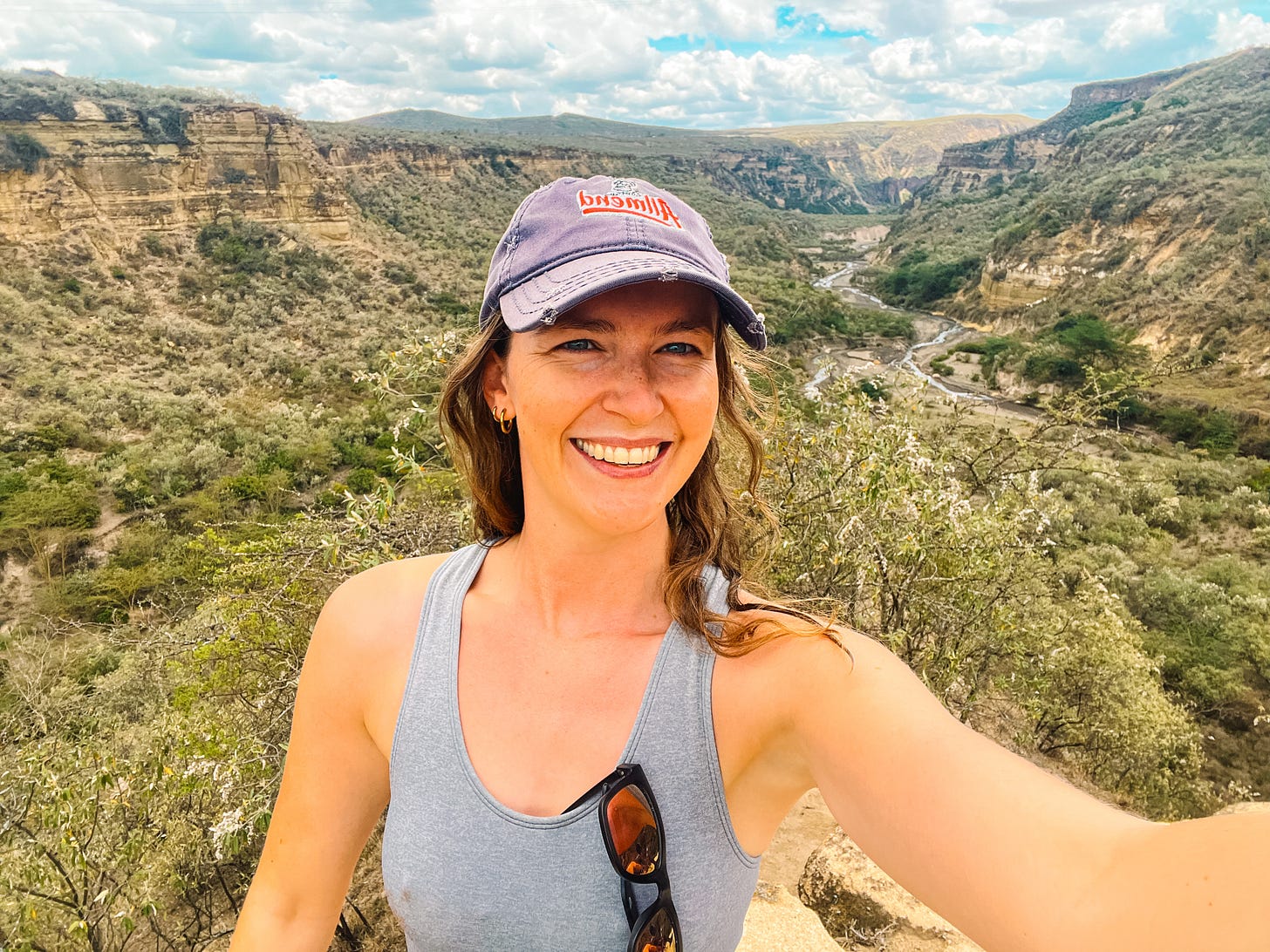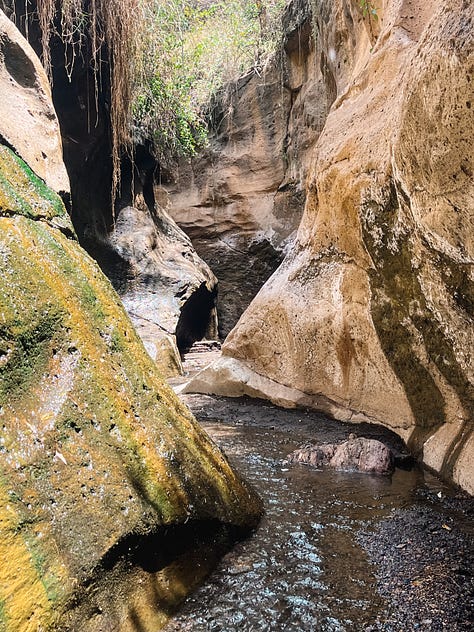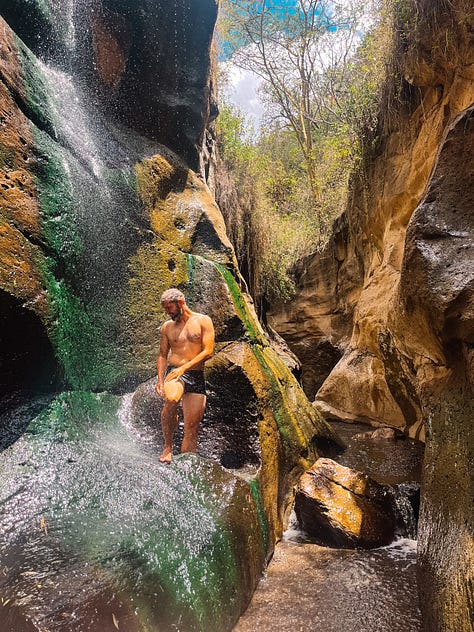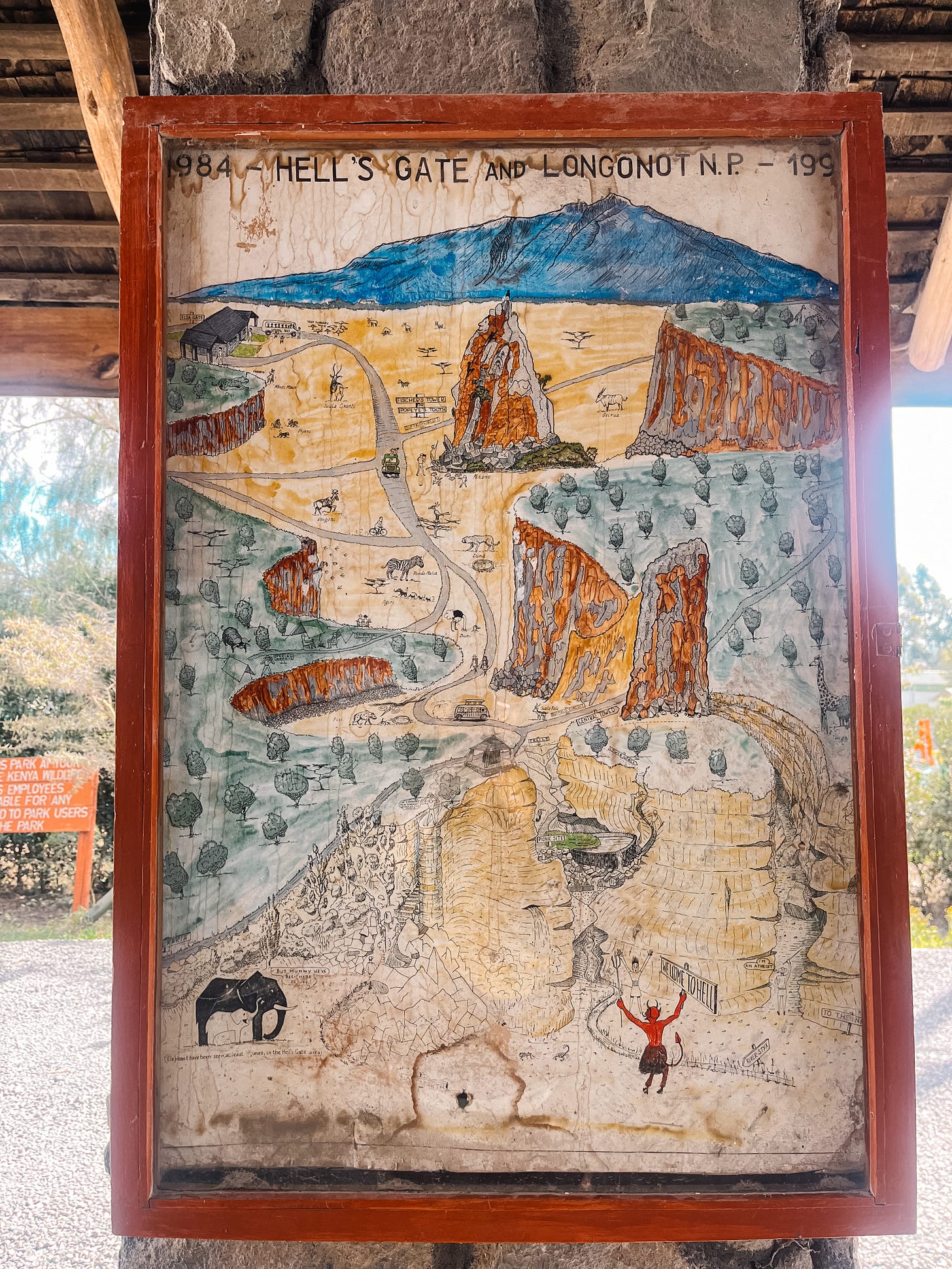Most people visiting Kenya put a trip to the Maasai Mara Game Reserve on their „must-do list”. The road there is long and bumpy, traversing through the expansive Maasai lands before terminating among the small bushy trees that dot the National Park. The national park is the northernmost section of the Mara-Serengeti ecosystem that covers some 25,000km2 between Kenya and Tanzania. While Maasai Mara is no doubt a bucket list experience, there are also other national parks in Kenya that are more accessible, easier on the wallet, and definitely worth the visit.
Hell’s Gate
We decided to swap out four wheels for two wheels and cycle around Hell‘s Gate National Park. We rented two half decent mountain bikes and set off early in the morning in the hot sun. It had been two months since I had worn proper shoes and several months since I rode a bike, so needless to say it didn’t take long for the complaining to start. Soon after entering the park we encountered zebras and Thompson gazelles minding their business and grazing alongside the path, which definitely took the edge off the fact that I was starting to experience what only could be described as saddle-burn.
Hell’s Gate, situated in the Great Rift Valley, is one of the only places in East Africa where you can hike the totality of a park. The lack of predators mean that you can come face to face with giraffes, zebras, antelopes, and warthogs on your own two feet—or better yet, on bicycle wheels. We did however come across buffalo, which we didn’t expect. We were pretty shocked, as buffalos are said to be the most aggressive animals of The Big Five, but we figure those ones must have been on the shy side seeing as we’re still alive. As well as that, we were luckily heading downhill at the time, so at least we could try outpace them? All I know is, I didn’t look back over my shoulder…
Hell’s Gate is the park that inspired Disney’s “The Lion King”, and since the movie is my longstanding favorite of all time, you better believe I wasn’t leaving without a selfie on Pride Rock. To get there we had to bike though the park to Ol Njorowa Gorge. To enter the gorge you need to hire a Maasai “guide” who walks with you throughout - the area is community-run by Maasai people. Maybe it was my imagination, but walking through the gorge felt somewhat familiar. I could imagine all the Lion King scenes playing out around me. I even felt emotional when we finally reached the top of “Pride Rock”, a massive rock that juts out of the ground in the middle of the gorge, and Raifiki was even hanging around as we were descending!

Our guide took us to an area that is usually out of bounds due to some accidents that happened over the years, which meant we could enjoy what could only be described as a “natural spa” all to ourselves. We took off our shoes and walked barefoot through the gorge, so we could enjoy the hot sand under our feet - this park is full of hot springs. The towering gorge walls started to hug tighter together above our heads the further we walked, blocking out the scorching midday sun. Now and again steam billowed out from the rocks above our head, until we reached a very narrow area where it was possible to strip off and take a hot shower in the mineral rich waters - our hair and skin felt super soft afterwards.



Ol Karia Geothermal plant
However these hot springs are not only useful for photoshoots, they’re also useful for generating electricity. Kenya, the world’s seventh biggest producer of geothermal energy, is developing the world’s largest geothermal plant inside of Hell’s Gate National Park. Why wouldn’t they want to harness the earth’s heat for clean energy, and take advantage of the fact that they only have to drill 900m into the ground to access it, as opposed to plants around the world having to drill to 3,000 - 4,000m for their geothermal wells. But of course it’s not a completely rosy picture, given that land rights abuses and disturbances to wildlife are widely reported. The park’s indigenous population, the Maasai, claim to be completely left out of the equation, and some people have claimed to witness a decline in wildlife numbers and species diversity in the park. We did pass by the geothermal plant and were quite shocked by the extremely loud machine noises of the vents, a continuous and inescapable banging sound that echos down the gorge, and could imagine how the noise alone would disrupt animals and birds. Although Kenya’s projects are supported by international sustainable development funding agencies, it seems they are still chipping away at the country’s natural heritage - it’s famous wilderness. It’s a real pity to see that even clean energy projects are not being held accountable for their negative environmental and societal impacts, just like our old fossil fuel friends…
Amboseli National Park
Amboseli is situated in the south east of Kenya, on the border with Tanzania. It’s a fairly small park, and is home to over 1,500 elephants - the highest concentration of elephants of all African national parks. The park is backdropped by Mount Kilimanjaro, making for a breathtaking atmosphere. Watching hundreds of elephants bathe in the park’s massive swamp with Kilimanjaro in the background will forever be one of my favorite memories.
We decided to self-drive our game drive in Amboseli, which we definitely didn’t regret. We saw thousands of animals, and were able to get to know the park really well during the two days we spent there. Long time readers might remember the experience we made on safari in Uganda (here), and how we were so disappointed with the whole thing. Well it seems that game drives are a lot more enjoyable when you don’t have a guide speeding you around in circles and following other tourist vehicles. We found it much more comfortable driving ourselves around in our trusted Subaru and leaving our animal sightings to chance.
For Amboseli we’ll let the photos do the talking…
For now there are no plans to disrupt the perfect ecosystem of Amboseli, and it still remains to be one of the country’s critical conservation landscapes. And while Ol Karina geothermal plant is one example, Kenya does have extensive plans for expanding their renewable energy infrastructure, which are being rapidly built to fulfill the aims of “Kenya Vision 2030”. This includes projects that are being developed near or in national parks, much like Hell’s Gate. Parts of Kenya remain unspoiled and are likely to retain their wildlife-rich wilderness, like the Maasai Mara National Reserve, which has the fortune of being privately managed outside the hands of the government, and Amboseli National Park. However that’s not ruling out potential infrastructure development (like power lines and roads) encroaching on their boundaries very soon - there are already railway lines going through Nairobi and Tsavo’s national parks. If you ever dreamed of going to Kenya to see the vast untouched golden savannas filled with zebras, elephants, giraffes, and lions, you should probably go sooner rather than later. It might be that the Kenyan government has the same idea, given their efforts to boost tourism with their recent decision to offer visa-free travel into the country. Could it be that they are worried about the repercussions of their controversial projects? Probably not. But one has to ask oneself - have no lessons been learned?















